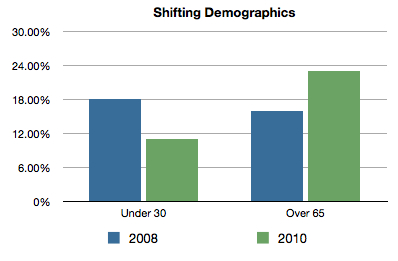In the midterm election last week Republicans took the House and won eight seats in the Senate. Their win, however, as Matthew Yglesias puts it, doesn’t simply reflect the “national mood.” Instead, it was partly a reflection of a shift in the demographics of the voters who turned out. Young voted still lean Democratic, and many more of them stayed home last Tuesday than two years ago.
See also our post on historic trends in voter turnout.
Via Jose Marichal at Thick Culture.
Lisa Wade, PhD is an Associate Professor at Tulane University. She is the author of American Hookup, a book about college sexual culture; a textbook about gender; and a forthcoming introductory text: Terrible Magnificent Sociology. You can follow her on Twitter and Instagram.

Comments 11
Ricky — November 9, 2010
The voters have spoken, and they said "Get off my lawn"!
Grant Joslin — November 9, 2010
You don't think it's possible that the turnout demographics shifted because of the "national mood"? That turnout is possibly affected by the same factors that affect who people vote for?
Casey — November 9, 2010
I would expect that mid-term elections generally draw an older crowd simply because there is less hype about them.
T — November 9, 2010
This is NOT a "demographic shift." This cannot be determined by looking at two unrelated pieces of data.
Presidential-year Election is an *entirely* different animal from a mid-term election! If they compared 2006 to 2010... or 2004 and 2008... then maybe you can use the word "demographic shift" when looking at the age groups that turned up at the polls.
Ben Collins — November 9, 2010
^^^ Agreed, T. Certainly not a demographic shift.
Going back to 1972:
For people >30 voter turnout drops by about 20-25% in midterm elections.
For people 18-29 voter turnout drops by about 45-50% in midterm elections.
(See here: http://www.civicyouth.org/quick-facts/youth-voting/)
Of course, this doesn't preclude a change in "national mood" having some explanatory power, but even taking these relatively stable proportional adjustments by age between presidential year and mid-term elections into account, the "national mood" argument is probably still under-historicized also. These shifts in "national mood" are far from uncommon in mid-term years in which the same party controls both congress and the white house. If we were in the business of making predictions, back in 2008 we could have put some good money on the GOP taking back the house (we probably would have put our money down for the senate too) in 2010. Of course it's a much more boring story than the "zomg there's a historically unprecedented shift in national mood and it TELLS US SOMETHING about Obama and about Democrats" type of tales that keep news industries churning along.
D — November 9, 2010
Is it possible to have a non-confusing graph on the site? Seriously, swap the years of 2000 and 2010 with the ages on the X axis, it would be a ton more clear.
Kemlyn — November 9, 2010
So, the 31-64 crowd is not particularly interesting?
Why the tide turned against Obama « Patrick Boltze — November 10, 2010
[...] aspect of the mid-term elections is that the Democrats didn’t succeed in motivating younger voters to vote as much as they did in the presidential election in [...]